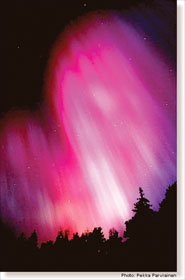|
observer |
|
|
|
|
|
OTHER LINKS |

|

|

|
|
Different types, structures and colours of aurorasRemember being introduced to a fascinating world of colours in our last 'Geo Facts' page? Then, we promised to tell you more about them today. So, here we are!
People were curious to know the altitude of the auroras. After some experiments, they got to know that most of the night time auroras are found between 90 and 150 kilometres. A few auroras may extend up to roughly 500 kilometres. The average altitude is between 100 and 120 kilometres. Do you know that the Sun radiates all visible colours, which makes the sunlight appear white? The aurora spectrum (band of colours), on the other hand, is not continuous, but is composed of a series of spectral lines and bands in the visible, the ultraviolet and the infrared ranges. The colour composition of the aurora is the atmosphere's fingerprint, which is the only way of identifying them. Altitude also affects the colour of the aurora. The strong, green light originates at altitudes of 120 to 180 kilometres. Red northern lights occur at even higher altitudes, while blue and violet occur mostly below 120 kilometres. When the Sun is 'stormy', red colour occurs at altitudes between 90 and 100 kilometres. Entirely red northern lights are sometimes seen, particularly at lower latitudes, and are often mistaken for a fire on the horizon. There are various aurora forms and structures as well. When you observe them from the ground, they all look the same, but there are more common patterns. Homogeneous arc, Arc with ray structure, Homogeneous band, Band with structure and Rays are some of them. Homogeneous arcs and bands, and diffuse (widely spread) surfaces are classified as quiet aurora forms. Forms with ray structures such as coronas, curtains, arcs with rays and spirals are examples of active aurora forms with rapid variation. |

 That day, you got an idea about what Northern lights are and how they
occur. Do you know from where the first realistic description of auroras
was found? It is from the Norwegian chronicle, The King's Mirror, from
about 1230 AD. This book was originally written as a textbook, probably
for the young King Magnus by his father. The youngster was taught about
all possible matters that he would need to know as a future ruler of
Norway. The aurora was described in the King's Mirror as a natural
phenomenon and was named Nordurljos, or northern lights. Although
Galileo Galilee, Italian mathematician, philosopher and astronomer,
wasn't the first to see the northern lights, he was the first to give it
its scientific name.
That day, you got an idea about what Northern lights are and how they
occur. Do you know from where the first realistic description of auroras
was found? It is from the Norwegian chronicle, The King's Mirror, from
about 1230 AD. This book was originally written as a textbook, probably
for the young King Magnus by his father. The youngster was taught about
all possible matters that he would need to know as a future ruler of
Norway. The aurora was described in the King's Mirror as a natural
phenomenon and was named Nordurljos, or northern lights. Although
Galileo Galilee, Italian mathematician, philosopher and astronomer,
wasn't the first to see the northern lights, he was the first to give it
its scientific name. 






